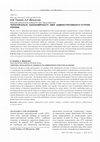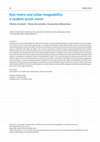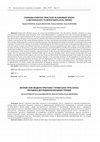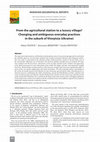Papers by Oleksiy Gnatiuk
Geographia Polonica
This paper describes and analyses the imageability and the perceptual portraits of the (post-)soc... more This paper describes and analyses the imageability and the perceptual portraits of the (post-)socialist largescale housing estates in Kyiv in the eyes of young people (university students). The research is based on the analysis of Lynch-type mental maps focusing on urban vernacular districts among the other their principal elements. The results show that mass housing areas still constitute an important part of the city’s image. However, apparently similar neighbourhoods differ significantly in terms of their imageability and likeability depending on their location in the city and the trajectory of the post-socialist development. Consequently, individual approaches to positive image change based on the complex evaluation of development factors are needed to response the challenges faced by the different types of the (post-)socialist mass housing.

Scientific Bulletin of Kherson State University Series Geographical Sciences
Метою цієї статті, у якій об’єктом дослідження виступають українські ойконіми, є демонстрація тог... more Метою цієї статті, у якій об’єктом дослідження виступають українські ойконіми, є демонстрація того, що деколонізація топонімії є складним і нетривіальним завданням, яке не має шаблонних рішень на національному рівні, однак потребує напрацювання принципів, підходів та процедур, які мали би виконувати роль дороговказу для органів місцевого самоврядування під часобговорення та прийняття рішень щодо перейменування населених пунктів. Для досягненнямети: визначено окремі категорії ойконімів в контексті їх можливої деколонізації; окреслено підходи, які можуть бути застосовані для нетривіальних випадків застосування ойконімів в кожній звизначених категорій; запропоновано можливі варіанти коригування існуючого ойконіму або жвибору нового в залежності від специфіки ситуації. Аналіз потенційних цільових кейсів доводить,що кваліфіковано проведені топонімічні зміни – це потенційна можливість не лише гармонізуватитопонімічний ландшафт України та відновити історичну справедливість, але й усунути з...
Routledge eBooks, Aug 25, 2022

Ukrainian Geographical Journal, 2020
Київський національний університет імені Тараса Шевченка ТЕРИТОРІАЛЬНІ ЗАКОНОМІРНОСТІ ЗМІН АДМІНІ... more Київський національний університет імені Тараса Шевченка ТЕРИТОРІАЛЬНІ ЗАКОНОМІРНОСТІ ЗМІН АДМІНІСТРАТИВНОГО УСТРОЮ УКРАЇНИ Метою статті є виявлення просторових закономірностей змін адміністративно-територіального устрою України на макрорівні та визначення можливостей їх практичного застосування при здійсненні адміністративно-територіальної реформи. Шляхом накладання послідовних історичних сіток адміністративного поділу було отримано мережу територіальних осередків з унікальною послідовністю перебування у сфері впливу адміністративних центрів першого порядку, для кожного з яких було визначено параметри їхньої адміністративної стабільності. Виявлені закономірності є своєрідним статистичним «відбитком» найбільш стабільних суспільних просторових структур. Найстабільніші осередки відповідають ядрам суспільно-географічного районоутворення, тоді як найбільш нестабільні осередки концентруються в зонах безпосередньої або опосередкованої конкуренції таких ядер і формують систему буферних зон між ними. Це дає підстави розглядати такі просторові структури як основу для коригування меж адміністративних одиниць країни на макрорівні на наступних етапах адміністративно-територіальної реформи.
Norsk Geografisk Tidsskrift-norwegian Journal of Geography, Feb 6, 2023

Hungarian geographical bulletin, Sep 29, 2022
The article addresses identity transformation in geopolitical fault-line city under a semi-frozen... more The article addresses identity transformation in geopolitical fault-line city under a semi-frozen military conflict. Until 2014, the Donbas, a region in the eastern Ukraine, had a strong identity cultivated by the local industrial and financial groups. The Russian-backed military conflict induced rethinking of Donbas identity, giving a chance for revival of silenced regional identities. Our case study is Mariupol, the second most populous city in Donetsk oblast and the informal capital of Pryazovia that stepped out from the shadow of Donetsk. The research is based on the survey data (n = 1,251) collected in 2020 through personal interviews, analysed using descriptive statistics and binary logistic regression. The hypothesis that emerging Pryazovia identity should qualitatively differ from presumably stigmatized Donbas identity was confirmed only partially. The identity rethinking seems to be neither rapid no straightforward. Donbas identity appears quite persistent, while Pryazovia identity functions mainly as a complementary one. Instead of escape from the stigmatized Donbas identity, we observe rather its redefinition, including on local-centric ("Mariupolocentrism") and Ukraine-centric bases.
Eurasian Geography and Economics

AUC GEOGRAPHICA
This paper aims to reveal and explain the role of metro stations in a post-socialist metropolis a... more This paper aims to reveal and explain the role of metro stations in a post-socialist metropolis as nodes that determine the perception of the city. By means of Lynch-type mental maps, we sought to find whether metro stations really function as perceptual nodes concentrating urban functions and traffic, and how recent changes of urban built environment and functions induced by neoliberal policy are reflected in the public perception. The results are discussed in relation to transit-oriented development that considers public transport stations and spaces around them as community hubs. The study has confirmed the expectation that the metro system constitutes an important part of the urban image and often functions as a skeleton that is used to arrange and frame the mental map of the city. Most of the metro stations function as perceptual nodes concentrating a particular urban function (monofunctional nodes) or combination of different functions (multifunctional nodes). The current perc...

AUC GEOGRAPHICA, 2020
This article focuses on geographical urbanonyms in Ukraine-names of streets, squares, lanes, etc.... more This article focuses on geographical urbanonyms in Ukraine-names of streets, squares, lanes, etc. that refer to the names of other geographical objects like cities, regions, countries, or continents. It shows the role of geographical urbanonyms as a powerful instrument used by political regimes to shape political identity by constructing and legitimizing borders between "us" and "them" at different spatial scales. The analysis revealed a significantly higher presence of geographical urbanonyms in Ukraine compared to former state socialist countries in Central Europe. The widespread presence of street names related to the former USSR proves the absence of post-Soviet decolonization in semiotic space, going beyond the pure decommunization, in the majority of Ukrainian cities since 1991. Regional differences in the dynamics, distribution and structure of geographical urbanonyms in Ukraine are explained by the historical, cultural and (geo)political divisions.
Odesa National University Herald. Geography and Geology, 2017
Проаналізовано просторові трансформації житлового мікрорайону Вишенька у місті Вінниці. Визначено... more Проаналізовано просторові трансформації житлового мікрорайону Вишенька у місті Вінниці. Визначено основні напрями функціональних перетворень, що мають місце на території мікрорайону, ключові агенти, що ініціюють зміни прилеглого міського простору, та суспільно-просторові процеси, які змінюють культурний ландшафт житлового мікрорайону у постсоціалістичному місті. Ключові слова: просторові трансформації, постсоціалістичне місто, житловий мікрорайон, суспільно-просторові процеси, Вінниця.

Geografický časopis - Geographical Journal
Place names for sale: A place of Ukraine in the universe of toponymy commodification The issue of... more Place names for sale: A place of Ukraine in the universe of toponymy commodification The issue of commercial use of geographical names, constituting a promising and booming area of the second wave of critical toponomastics studies, remains poorly investigated in Ukraine. Simultaneously, Ukraine, passing a long and controversial post-Soviet transformation, represents a real honey pot for scrutinizing the commercial use of place names and its consequences for cultural landscapes and territorial communities. The aim of this article is to show Ukraine, as a country representing economically, socially, politically and culturally-specific part of the post-Soviet realm, in the global arena of toponymy commodification, creating the basis for further research in the field. The research methods include analysis of existing scientific literature, media screening, analysis of the names of residential complexes in Kyiv and its suburban area, field observations and the study of the legal framework. The most common form of toponymic commodification in Ukraine is the use of local geographical names and the names of historical regions for marketing purposes, in particular branding of goods and services. Gentrification-led type of toponymic commodification has already changed the symbolical space of the largest Ukrainian cities, while the possibilities for and practices of the infrastructural toponymic commodification are still quite limited although several existing cases may represent an early sign of upcoming global trend. In the field of tourism, an emerging practice is the use of formal and folk toponyms in order to create thematic cultural landscapes.

The relationship between national and local patriotism is an important scientific issue in view o... more The relationship between national and local patriotism is an important scientific issue in view of modern socio-political crisis inUkraineand arising processes of regionalism and separatism in many countries throughout the world. The paper represents an attempt to disclose and understand spatial patterns of local and national patriotism inUkraine. This case-study was focused on Podolia in view of significant internal historical and cultural diversity. The data for analysis was collected by means of a questionnaire survey that make possible to assess separate aspects of local and national patriotism as well as calculate their integral indices. Indicators for local patriotism assessment are as follows: presence of small motherland, love and proud of the settlement (topophilia), preferable consumption of local products, and support for local sports teams. Indicators applied for national patriotism evaluation are: mental attachment toUkraine, willingness to be born again inUkraine, and ...

Ekonomichna ta Sotsialna Geografiya, 2019
Urban and suburban spaces are social and multidimensional. The city and its suburbia constitute a... more Urban and suburban spaces are social and multidimensional. The city and its suburbia constitute an arena of diverse and conflicting social processes. Their social differentiation is manifested, first of all, in housing segregation and diversity of various types and forms of life activity. Social interactions and relationships between individuals and social groups take place in the social space of the city and the suburbia. Their behavioural practices lie at the intersection of economic, social, cultural, environmental, and urban planning domains of urban functioning and manifest themselves in everyday practices. The concepts addressing the research of everyday practices were designed and tested in the fields of sociology, history, and economy. The goal of this article is to develop a methodology for the study of local trends of changing everyday practices in suburban spaces of cities with different functions on the bases of human geography and urban science. The authors propose to s...

Geographica Pannonica, 2018
Post-socialist urban transformation constitutes an important segment of the contemporary urban st... more Post-socialist urban transformation constitutes an important segment of the contemporary urban studies. In this paper we focused on transformation processes in two typical post-Soviet residential neighbourhoods, built in the period of mass construction in the second half of XX century and located in the Ukrainian cities of Vinnytsia and Kherson. Our goals were to reveal the spatial and temporal transformation patterns, to identify the factors of transformation, and to delineate certain transformation mechanisms and models. The assessment of morphological and functional changes of urban objects was carried out via field observation according to a specially developed methodology with the further comparison of results with urban planning documents reflecting the reality in the beginning of 1990s. Our findings permitted to identify key transformation processes (deindustrialization, commercialization, revitalization, functional diversification), to list a set of factors promoting more intense transformations, and to explain mechanisms defining existing spatial pattern of transformations within the test neighbourhoods. Private commercial activity, including rapid development of retail sector, was the main source of transformation, thus defining its partial, fragmented and somewhere controversial nature. Since the probability of further transformation in each point of the territory is determined by the already existing pattern, the existing heterogeneities tend to enhance with a lapse of time, and therefore the initial stages of transformation are especially important for the further development of the neighbourhood. Despite the similar starting conditions, two neighbourhoods demonstrated different outcomes in terms of modernization, explained by the differences in the urban spatial structure, spatial and sectorial structure of industrial zones, position (importance) of the neighbourhood in the whole city, as well as the economic dynamics of the city. Based on detected factors and mechanisms, we proposed models for further transformation intended to maximize the level of modernization within the entire test neighbourhoods.
Spatial Conflicts and Divisions in Post-socialist Cities, 2020
Geografický časopis - Geographical Journal, 2021

Moravian Geographical Reports, 2021
The study of everyday practices, self-identities and perceptions seems to be a promising approach... more The study of everyday practices, self-identities and perceptions seems to be a promising approach to understand the suburban spaces as not only static containers but socially constructed, dynamic and ambiguous entities. Our case study is represented by the suburban village of Ahronomichne, located in the peri-urban area of the second-order Ukrainian city of Vinnytsia. The research methods included survey of residents (67 long-term residents and 59 newcomers), observations of the everyday activities of the residents and appearance of the build environment at seven observation points within the village, and four semi-structured in-depth interviews. We found that everyday practices of the long-term residents and newcomers significantly differ in terms of their set, spatial configuration and actual exercitation. The other important factors contributing to the variety of everyday practices and lifestyles are type of housing, age and family status. Simultaneously, we observed not just a c...

Hungarian Geographical Bulletin, 2021
The paper tackles the issue of uneven geographical representations on Wikipedia, the most visible... more The paper tackles the issue of uneven geographical representations on Wikipedia, the most visible and powerful user-generated encyclopaedia. In particular, it addresses language imbalances on Wikipedia with regard to geographical information and uneven spatial patterns of territory coverage on the different language versions in an attempt to verify expectations about the cultural factors that influence these imbalances and uneven spatial patterns. Ukraine is a promising case for testing the formulated expectations, as it has a large number of neighbouring countries, and most of them had political and cultural influence on its territory in the past. The volumes (word counts) of articles about the Ukrainian cities were analysed for seven language versions of Wikipedia, including the Ukrainian version and the versions of all bordering countries. The results show that historical geography is the strongest and central factor, and most of the key relic borders (former boundaries) can be t...

Geographia Polonica, 2020
Naming and renaming of urban space often is sensitive in terms of the street location and status ... more Naming and renaming of urban space often is sensitive in terms of the street location and status and implies categorization of streets according to the perceived importance of a street name. Thus, different locations in the city have different symbolic significance, and the urban toponymy could be read as a spatial projection of the societal axiological system. This article represents an attempt to study the importance of location (centrality vs. peripherality) and status (significance) of the urban public spaces in the 36 largest Ukrainian cities in terms of symbolical value and memory policy. The findings indicate that both investigated factors constitute an important tool of identity shaping and historical memory policy, but their influence and manifestation may vary considerably depending on specific historical, cultural and (geo)political conditions. Therefore, although the central parts of cities and the main urban arteries have tangibly larger symbolic significance, the topon...







Uploads
Papers by Oleksiy Gnatiuk